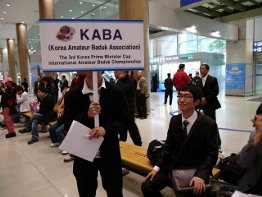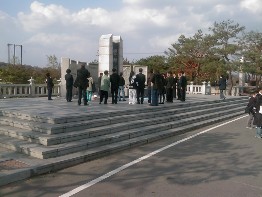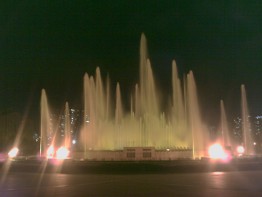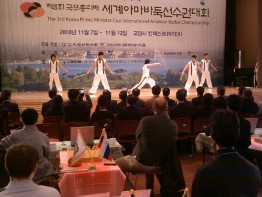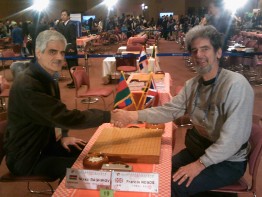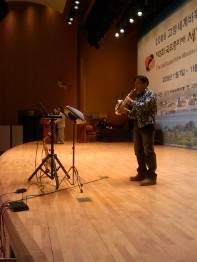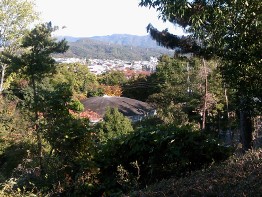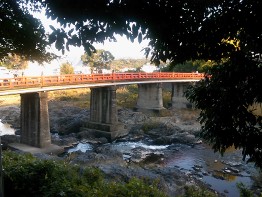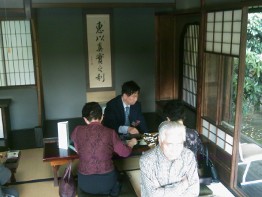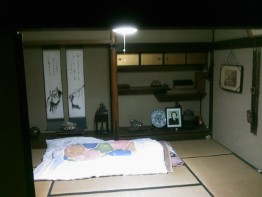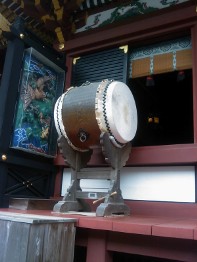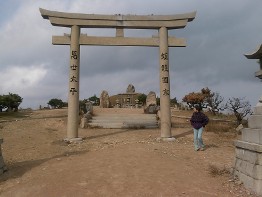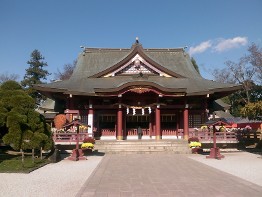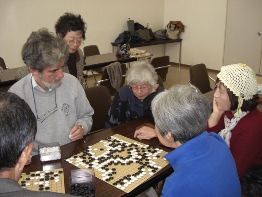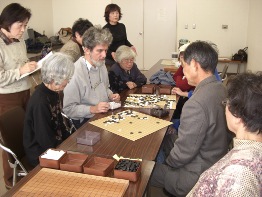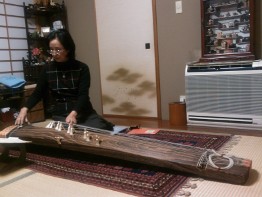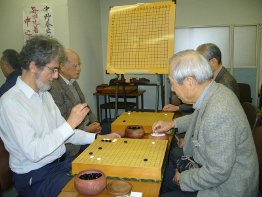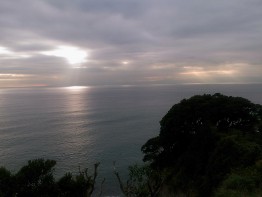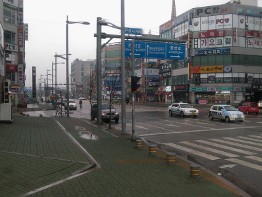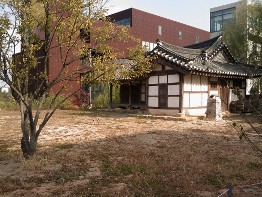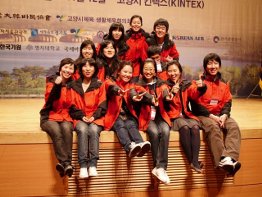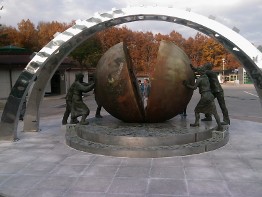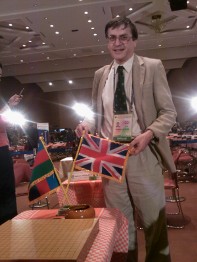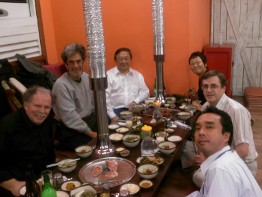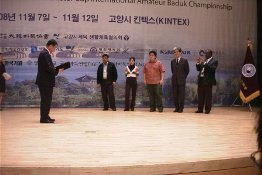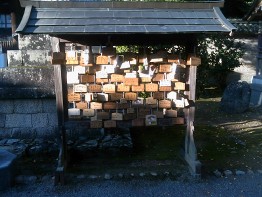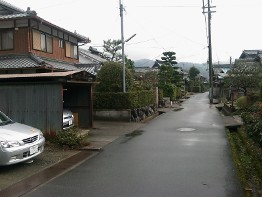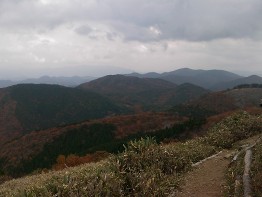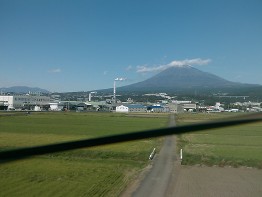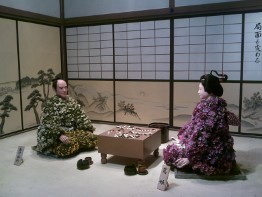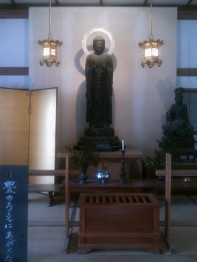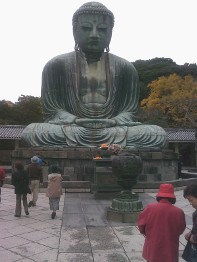| Navigation |
|---|
| Home |
| Christmas newsletter |
| Site index |
| ||
| ||
| ||
| ||
| ||
| ||
| ||
| ||
| ||
| ||
| ||
| ||
| ||
| ||
| ||
| ||
| ||
| ||
|
I was selected by the British Go Association to represent the UK in the 3rd Prime Minister Baduk Tournament held by the Korea Amateur Baduk Association (KABA) in Goyang, near Seoul. Representatives were invited from all go playing countries with a national organisation. 68 countries sent representatives, chosen in a variety of manners. One contestant told me that she was there “because her teacher had told her to go”.
However, a somewhat more rigorous selection procedure was used by the BGA. My trip was a reward for persistence rather than competence, on the basis of the number of games that I had won at British Go Congresses. I decided to follow my week in Korea with a fortnight in Japan, as I have many friends there. Here is a Korea/Japan diary of my visit.
Thursday 6th – Friday 7th
In the flight from Heathrow to Seoul with Korean Air, I am impressed by the wide range of in-flight entertainment. A choice of five Bruckner symphonies gives an idea of the range available. I am met at Seoul Incheon airport by representatives of KABA, and after two hours the transport to the hotel in Goyang arrives. I find that I am sharing a hotel room with Tony Atkins, who is there representing the EGF as its president.
Saturday 8th
After some orientation speeches we are introduced to our team of “interpreters”. These are students, (not generally baduk players), identified by red shirts, who are not only able to speak fluent English and other languages, but serve as our guides throughout our stay. These people were quite exceptionally competent and friendly.
After lunch we are shipped off for a sightseeing tour centred on the DMZ (demilitarised zone). I think that some of us might have preferred some Korean history and culture, but it is understandable that the sad division of the country looms large in the Korean mind. A depressing sight was a religious ceremony (Buddhist I think) at a monument to families which have been split for many decades by the division.
The most interesting part of this trip is a walk down a long slanting concrete passage to see one of the four tunnels so far discovered bored through the granite rock under the DMZ by the North Koreans, and now firmly blocked off. We are told that these were intended for the invasion of the South. Maybe, but it looked to me as if only infantry and light artillery would go through such a narrow space.
We have to wear hard hats, and need them. Walking up to the surface is physically challenging, as we climb the equivalent of a 20-storey building. “Do you fear invasion from the North now?” I ask a guide. “The mouse does not attack the cat”, comes the reply. There is a striking sculpture of a divided sphere on the surface, symbolising the desire to reunite the country.
Later that evening we have a banquet. Having registered as a vegetarian, I find myself sitting on a table with the other vegetarians, including three Indian players. (Two are there as officials for the discussion meetings going on at the same time as the tournament rounds.) It is good to see that vast and increasingly prosperous country developing baduk.
After that we are taken to see the “singing fountain”, which changes form and colour in time with recorded classical music. Impressive for ten minutes, but after 30 standing in the cold I am ready for the bus back to the hotel.
Sunday 9th
The tournament is held at KINTEX (Korea International Exhibition centre); an impressive edifice comparable with our one at Birmingham, and a 20 minute bus ride from our hotel. We are in the Grand Ballroom, and have the standard oriental opening ceremony with speeches and introductions galore, together with what seems to be usual on these occasions, some stage entertainment. This consists of an impressive choreographed exhibition of the martial art Tae Kwon Do, which has been unkindly described as the art of kicking people in the face.
After lunch the tournament proper starts. There are various other baduk events going on in the same vast hall, including a children’s tournament. The Koreans do not appear to expect the same hush that surrounds the start at least of most European tournament rounds. The time limits are somewhat unconventional for an international tournament: 30 minutes basic time with three allowances of 30 seconds byo yomi. This leads to a schedule in which many of us have a lot of sitting about to do, while one or two pairs finish most of their game in the byo yomi phase.
You found your table by identifying your national flag displayed thereupon. Tony notices that the Union Flag is attached to its miniature pole upside down. “A symbol of distress,” he remarks. (The distress is to come later.) My first opponent is from Azerbaijan. My punishment for beating him is to be promoted by the Swiss system draw to table 2 for round 2, and have my game against the 6-dan Czech player broadcast to the world on the internet. I lose easily.
Monday 10th
We are moved from the Grand Ballroom to a smaller room for the remaining rounds, as the other Baduk tournaments were only for one day. After a poor night’s sleep I manage to lose all my games, to Australia, Spain and Indonesia. We are fed magnificent lunches at KINTEX under the watchful guidance of the interpreters, at a different restaurant each day.
In the evening Tony Atkins, myself and several others are invited out for a Korean style dinner with Mrs. Taki of the International Pair-Go Organisation. This entails squatting Japanese style around a table bearing a bewilderingly large array of small dishes; I counted 69. Korean food is quite different from Japanese; more meat oriented, and often quite hot in taste.
Tuesday 11th
I make up for my poor performance on Saturday by beating Mexico, Brunei and Turkey. There is the usual final ceremony; this time the entertainment is a young saxophonist playing karaoke style with CD accompaniment. 4/8 doesn’t qualify one for a major prize, so I am rather surprised at the final ceremony to be nominated for a Special Prize. These were awarded to the sole female competitor, the player who lost all his games, the most popular player, as voted for by the interpreters, and to myself for being the oldest competitor (I’m 65). They couldn’t award a Special Prize to the youngest competitor, as he was the Chinese player who won the tournament anyway.
Wednesday 12th
Time to leave Korea. The interpreters are there to the last, to guide us to the airport buses. I fly to Osaka, and by means of a bus and two trains, interrupted by a moment of panic as I forget how to buy train tickets in Japan (all done by machine with instructions in clear Japanese), I arrive at the town of Hirano, in Hyogo prefecture.
I am there to visit Harumi Takechi. Anyone who frequents the European Go Congress will know her. She is also to be seen at the US Congress, and has visited us at the Isle of Man event. She has a particular love for overseas (to her) go players, and regularly invites them to visit her in her home.
Where they receive a warm welcome; literally so in my case, as she whisks me off to the local onsen (thermal baths). As always in Japan, you take off your shoes on entry; they go into a locker. Then you enter the changing room and put all your clothes plus the first locker key into a second locker, and go through to the baths. Here you are expected to shower very thoroughly, before you just relax in the hot water. If it’s not hot enough for you, there’s a sauna as well, with a timer to show you when you’ve been in there 12 minutes, considered the maximum for safety reasons. I manage about three.
Thursday 13th
I am left to my own devices, while Harumi goes off to a meeting in Osaka, and a welcome relief it is from the bustle of the preceding week. In the afternoon I go for a long walk, ending at the extensive local Shinto shrine. Here you can pray to the local kami or spirit, asking for your request to be granted. Apparently you can increase the chance of getting what you want by buying a small tablet of wood, writing your prayer upon it and tying it to a stand. The priests periodically collect these up and pray for them en masse. (No pun, really …). Later I find a quiet spot by a river for some peace. In the evening Harumi and I play go.
Friday 14th
I have been invited, through Harumi, to attend the 40th Anniversary party of the Kyoto Women’s Igo Kai (go association). I fail to appreciate the need to catch a particular train, resulting in a somewhat hurried journey to the Kyoto venue. I am the only foreigner present. There is an informal two-round tournament. When I announce my strength as 3-dan, I am unhesitatingly entered at 5-dan, following which I win both games. Draw what conclusion you will. We are also given a game against a professional; that I don’t win, having been allowed only two stones handicap. Amongst other pros ex-Honinbo Rin Kai Ho is present, and is now in possession of a BGA name card, so he at least knows that we exist.
The go song, a British invention, has now spread to Japan. The party wanted a rendition of the Niken Tobi song, which I am called upon to sing, in the original Kielerisch dialect of German. I then discover that everyone present had been issued with a copy of the song downloaded from my own website at http://www.francisroads.co.uk/gosongs/03NikkenTobi.pdf, with some of the German text replaced by a Japanese version, which was then sung by all present.
During the banquet which follows, I have some trouble convincing people that I am British rather than German. I am seated next to a reporter from the local Kyoto newspaper, and my rather elementary Japanese is put through its paces as I explain who I am and how I learnt go, etc. Some Japanese still regard the idea of gaikokujin (foreigners) taking an interest in Japanese culture as rather exotic.
Saturday 15th
Another most welcome free morning at Harumi’s home, after yesterday’s excitement. In the afternoon we set off for the home of Matsumoto-san, a strong amateur player who maintains a Japanese-style house in the country, where he holds weekend go parties. I had been there before in 2004, and was well prepared for Japanese style living, with virtually no furniture, thin sliding screens dividing the rooms, tatami mats underfoot, and somewhat rustic insulation from the weather. Matsumoto-san keeps a record of every game played, using a sliding handicap system. In 2004 I lost nearly all my games, and slid down on his scale. This time I manage to make up most of the lost ground.
Sunday 16th
We set off for Kyoto again on a sightseeing trip. We visit the San Ju San temple, where there are 1000 statues of the Buddha, all different. There is some serious idolatry going on here, as people have left offerings of sake (rice wine) and, would you believe, chocolate cake at the feet of some of the statues.
In the afternoon Harumi, knowing my interest in all things musical, has kindly booked for us a visit to the museum of gagaku (imperial court music). This turns out to be a room full of gagaku instruments: ryuteki (flutes), hikirichi (shawms), sho (mouth organs), biwa (lutes), koto, and various percussion. (The English names are the nearest I can get in describing these instruments.) The curator spends much time talking about these in Kyoto dialect, but very little in actually playing the instruments. Photographs are not allowed, and there is no literature or CDs available. So I don’t learn as much from this visit as I was hoping to.
We spend the night at the home of the Izaki family. Mrs Izaki is a prime mover in the Kyoto Women’s Igo Kai, so we have met already. We spend the evening playing go.
Monday 17th
Harumi was hoping to show me the imperial palace. But it is closed for cleaning, following some weekend event, so instead we visit the garden of the Sento (dowager empress’s) palace. Japanese have to book their visit weeks in advance, but by showing my passport I get us in straightaway. I love Japanese gardens, with their tasteful placements of rocks, water, moss, shrubs and few flowers. This one is superb in the sun with the autumn colours on the trees.
Harumi treats me to a seven course “autumn lunch” at a local restaurant. Each course has a seasonal theme; this is a very Japanese thing to do. The weather turns cold for the first time, and we head for home, and the onsen again in the evening.
Tuesday 18th
Another restful day. We make a late start for Miyama, the local mountain where you park about a 30 minute walk from the summit. There are good views from the top, reminding me that most of Japan is mountainous, which is why the population is so crowded into the flat bits. Typically for this country the summit boasts an adjacent Shinto shrine and radar installation.
At lunchtime Harumi finds the noodle restaurant that she had in mind closed. Late lunch at another one. In the evening I am taken off to a go club for medical doctors, after which I am taken out for another generous Japanese meal.
Wednesday 19th
Time to leave Kansai (West Japan) and head for Mito City via Tokyo. This entails the use of six trains, including the famous Shin Kan Sen, or bullet train as it is often known. I get the usual good view of Mt Fuji as we pass. I have phoned Sadao Ito-san in advance, and he is waiting for me at Mito station.
Ito-san is a go player whom I met at the European Go Congress in Leksand last summer. The EGC is a good place to make this sort of contact. He drives me to his home, where we play go, followed by yet another huge Japanese dinner. My Japanese friends seem to be aware that I like to do as much as possible Japanese style, and I am supplied with the usual futon in a Japanese style room.
Thursday 20th
After a game or two, Ito-san drives me to a shrine in nearby Kasama town, where there is a spectacular floral display. There are a number of scenes where ningyo, or life size human figures, are placed in various poses. I couldn’t resist photographing the two ningyo playing go. We visit briefly a sake distillery, where you can try sips of each type of sake. I select a strong bitter sake as my favourite, and then with characteristic Japanese generosity he buys me a bottle.
After a noodle lunch we visit an old Japanese house in the country, which has been converted to an art centre. Then back to Mito with Mrs Ito for dinner in a sushi bar. I am almost embarrassed by the large quantity of food that is ordered; I know that I cannot get through anywhere near my share of it. But then my embarrassment is saved by the appearance at the end of doggy bags. This civilised custom seems to be spreading to Japan from the USA. It can’t come to Britain too quickly in my opinion.
Friday 21st
Ito-san runs a go club for people of pension age. He has sound ideas about the value of go in staving off the mental degeneration which often attends old age. The members are fairly weak, and there is a preponderance of female players, which is unusual and most welcome for any go club. They do not usually meet on a Friday morning, but this is a special meeting in my honour. I play a number of two-on-one handicap games, and win most, until towards the end of the morning when some of them get the knack of beating me. Then it is back to Ito-san’s home for lunch, and then back to the station to catch a train back to Tokyo.
The only British person whom I have planned to visit is my cousin Vernon, who runs Mayflower, an English Language school in Senzoku, a Tokyo suburb. Regrettably he is not a go player. Following a Japanese style Italian dinner, he kindly lends me his flat to sleep in, while his Japanese wife visits her mother, and he dosses down in the school itself. I sleep in a bed for the first time during this visit to Japan.
Saturday 22nd
Restful morning; once again, much needed. In the afternoon Vernon takes me to a Picasso exhibition at the Tokyo main art gallery. I am interested in 20th Century art, but I would have enjoyed it much more if it had not been so crowded. I think that the lack of anywhere to sit down was deliberate. An hour or so of that was quite enough.
After a walk through the city in the evening I am treated to my first Indonesian dinner. The variety of international cuisine in Tokyo is almost up to New York standard.
Sunday 23rd
After taking my leave of Vernon at Mayflower, I make my way to Yokohama to meet Kiyoshi Sekiguchi-san. He too was at Leksand, and I had also visited him during my 2004 trip. He takes me to his home, which transpires to be adjacent to what I can only describe as a Japanese equivalent of Epping Forest. We have a pleasant walk, with another chance to enjoy autumn colours. Then back to his home for go and dinner. In the evening there is a special treat for me. Mrs. Sekiguchi is a professional musician, and she gives me a private recital of koto music.
Monday 24th
In the morning it is more go, and then I have to return to Tokyo to make my final visit, to Take Ichikawa-san; yet another of my Leksand contacts. I meet him near Tokyo Central station, whence he takes me to a nearby go salon to meet a group of his friends. After an afternoon of go it is, yes, the usual, a splendid Japanese restaurant meal. Then after a train ride to Kamakura Ichikawa-san leads me to a hotel, with apologies for not being able to accommodate me himself. He even insists on paying the bill.
Tuesday 25th
Ichikawa-san meets me at the hotel for a rather full day ahead; my last of this visit. First we visit a nearby Buddhist temple. I am struck by a figure of the Buddha with a halo; not so very different from how one often sees Christian saints depicted. I wonder if there is really so much difference between all these religions. Then on to the famous Daibutsu (Great Buddha) of Kamakura. This is a vast bronze statue erected in mediaeval times, for which totally new casting and assembly techniques had to be developed. You can actually go inside it.
After lunch we travel on via a narrow gauge single line railway which runs along the coast to Enoshima Island, a local beauty spot. This you approach along a causeway, and ascend by means of three escalators. There are good views of the Pacific Ocean from the top, but we are now getting short of time. We hurry back to Ichikawa-san’s home for one more go game, and then it is off to another house where his wife’s recorder group have been rehearsing.
I had emailed them some of my music beforehand, and I notice that one of my own compositions for four recorders was on the music stands when I arrive. But we don’t play that, because with myself there are now five of us, so we play five-part music by Praetorius, Morley, Holborne and similar composers. Then tea. I speak more Japanese that afternoon than on any other occasion. I learnt some at evening classes about 20 years ago, and it does come back to you after a fortnight in the country.
Then it was off to the station for a train direct to Narita, for a night in an airport hotel before an early flight. It was the only time that I have been, for a time, actually lost in a hotel.
Wednesday 26th
Because the flight booked for me by KABA was naturally between Seoul and London, the rest of the trip being at my expense, my trip home is to be in two stages, with a night in a Seoul hotel. I arrive at Incheon Seoul airport without trouble, but then I have my one and only misadventure. I enquire at the information desk where to find the shuttle bus for my hotel. They don’t know, but ring the hotel for me. “Go the exit door 14 and wait outside,” they tell me. So I do that. After a short wait a taxi pulls up and hails me. “Are you from Incheon Sevilla Hotel?” I ask. “Yes” comes the reply. After quite a lot of driving and a taxi bill mounting up, it becomes obvious that something is wrong. We stop by the motorway and mobile phone calls are made. After several of these it becomes apparent than I am being taken to the wrong hotel.
We head back towards the airport, and eventually I reach the correct hotel, to be asked by the receptionist why I had not been waiting for their shuttle. I don’t think this was a taxi rip-off situation; more a language problem. At any rate, the hotel pays the taxi fare, and I am left with the feeling that if I had spoken Korean, even to the minimal extent that I speak Japanese, this would not have happened.
Anyway, the receptionists are very pleasant about the whole affair, and are intrigued to see my Special Prize (a miniature 9x9 goban) and to hear about my experiences of a fortnight before. In theory I could now have caught the train into Seoul for sightseeing. But I have had enough, and confine myself to exploring Airport City, a striking example of concrete, gridplan and neon architecture, and watching TV in the hotel. There are 79 channels available, including CNN, BBC World, a classical music programme and one which broadcasts wall-to-wall baduk. (There is a similar channel in Japan, which broadcasts both go and shogi). I opt mainly for baduk, and pick up a few words of Korean in the process.
Thursday 27th
I catch a mid-morning shuttle to the airport, giving me a couple of hours to spend my remaining yen and won on souvenirs. Then the 12½ hour flight back to London, home, and into jetlag recovery phase.
Impressions
Although I had visited Japan twice before, this was my first trip to Korea. The appearance of the place is similar, but you soon spot the differences. The Korean language is written in a phonetic script which you can actually read, even if you don’t know the meaning of each word. The food is different, as mentioned above. There are churches on many streets, as Christianity has a large following. And there is perhaps a more relaxed attitude to organisation.
I am very conscious of the generosity of KABA and its sponsors in giving me this expenses-paid trip. I enjoyed myself greatly, especially in the opportunity to meet so many people from other go/baduk-playing countries. But I could have played much better myself if I could have had some decent nights’ sleep, and I would have been more likely to have those if I had not been made to share a hotel room, however civilised my roommate. I hope that KABA will give attention to this matter in future.
My overriding impression of the Japan leg of my journey is of the overwhelming hospitality, friendship and generosity of all my friends. They put themselves to tremendous lengths to make my trip enjoyable and memorable. It was actually quite hard to spend any money, as people kept buying me meals and paying entrance fees. I love Japan, and its people, history and culture. I do hope to be back.
| ||
| ||
| ||
| ||
| ||
| ||
| ||
| ||
| ||
| ||
| ||
| ||
| ||
